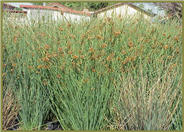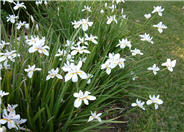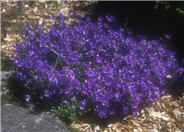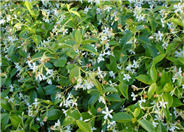
Common name:Quartz Creek Rush
Botanical name:Juncus effusus pac. 'Quartz Creek'
This selection of Juncus is widely used in landscapes due to its carefree nature, rigid upright structure and bright green color. This Juncus initially grows very rapidily and then slows to eventually to 36" wide and then clumps. It will reach a height of 24"-36". It reguires fairly regular water in the warmer months to perform well.

Common name:Butterfly-Iris, Fortnight Lily
Botanical name:Dietes iridioides
This clumping evergreen Iris bears tall, narrow leaves to 30" tall and white flowers marked purple in the center on stalks up to 3' tall. This variety has stiffer, darker foliage than the bicolor form. It requires sun to part shade with little or no summer watering when established.

Common name:Dalmation Bellflower
Botanical name:Campanula portenschlagiana
The Dalmation Bellflower is a mounding, deciduous perennial that forms a curtain of purple flowers often blooming in waves throughout the year. It should be grown in areas with sun to partial shade.

Common name:Small Cape Rush
Botanical name:Chondropetalum tectorum
Chondropetalum tectorum has 3'-4' tall stems that shoot out in all directions from the roots. Each stem has papery bracts connected to the ends that turn from tan to dark drown, then fall off. Chondropetalum can grow in marshes, in the ground with regular watering, or in drought conditions.

Common name:Star Jasmine
Botanical name:Trachelospermum jasminoides
The Star Jasmine is an evergreen vine that grows 20' tall or as a groundcover that reaches 1'-2' tall and 4'-5' wide. It has white fragrant flowers in the summer and can tolerate sun or partial shade. The Star Jasmine is also drought tolerant.
| Designer: | Winding Pathway |
Photographer: GardenSoft |
Soils and Compost:
Physical weed control, including mulching, or hand removal protects the watershed from harmful chemicals.
Water Saving Tip:
Irrigate in the early morning to minimize evaporation.
Integrated Pest Management:
Remove irrigation water and fertilizer from areas where you don't want weeds to grow.

